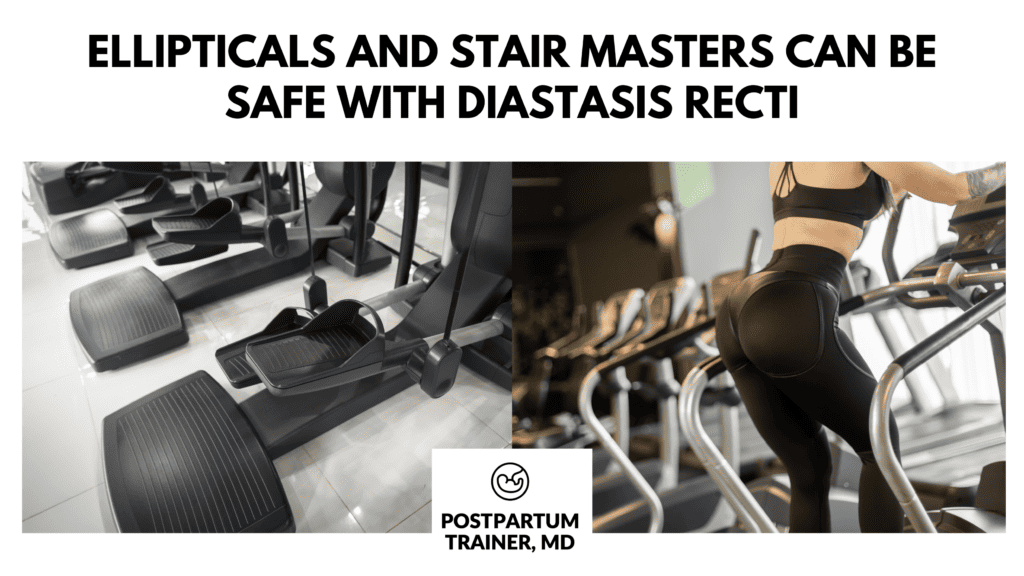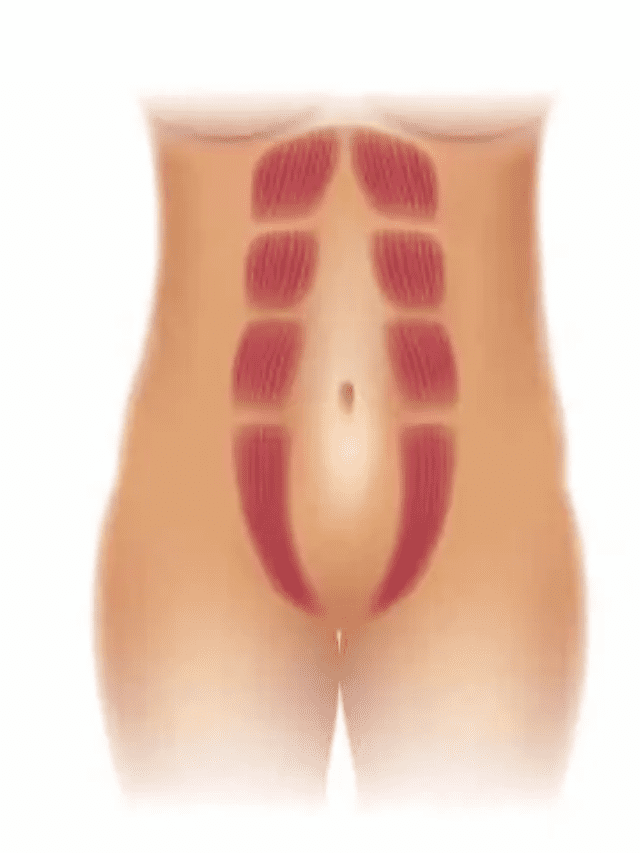Is it safe to do cardio with diastasis recti?
Yes! Cardio is a safe way to regain your fitness if you have diastasis recti. But it’s important to take the time to figure out what kind of cardio exercises are best for you.
Some forms of cardio can place a lot of strain on your core, worsening your abdominal separation.
This article will explore some effective cardio exercises you can do with DR.
The Best Cardio Exercises for Diastasis Recti
Below are the best types of cardio workouts for postpartum women.
But before you do any exercise, make sure to speak with your healthcare provider first.
Walking
Walking is the safest form of cardio if you have diastasis recti.
It’s gentle on your core muscles, and you can scale the intensity depending on your fitness level. It’s also low impact, so it won’t cause too much strain on your joints.
You can start with 10-minute walks several times per week. You can then increase the intensity or distance as you become stronger.
After some practice, jogging, and light running are also safe options.
Swimming
Swimming is another fantastic low-impact cardio workout that is suitable for diastasis recti.
The water supports your body weight, so the impact on your core is minimal.
It also provides full-body resistance training without straining the ab muscles.
Like walking, start slow and increase the intensity over time.

Elliptical
The elliptical can also be effective for a new mom with DR.
It mimics running without the added impact. As such, it helps reduce strain on your abdominal muscles.
As you use the elliptical, focus on keeping a good posture. Keep your hips in a neutral position and your spine straight.
This posture will keep your abs engaged in a safe way.
Cycling
Cycling on a stationary bike is also safe for diastasis recti.
This cardio exercise targets your legs and protects the core.
With that said, I am not a huge fan of lots of cycling postpartum. Cycling can lead to a tightening of the hip flexors. Postpartum women already have tightness in the hips from uneven pregnancy weight gain.
If you’d like to try cycling, I recommend doing it for short intervals with low resistance.
Be sure to adjust your bike seat to a comfortable height to avoid stress on your knees and pelvis. Also, avoid bending over the handlebars.
Instead, keep your head up, core tight, and pelvis neutral.
Stair Climbing (With Caution)
Stair climbing can be another excellent cardio exercise for diastasis recti. It is low impact and helps improve core stability by forcing you to use one leg at a time.
As you climb stairs, engage your deep abdominal muscles and maintain good posture. Keep your spine tall, your shoulders back, and your glutes active.
Keep the speed slow so that you can focus on proper form and engage your core.
If you go too fast, you will increase the strain on your abdominal muscles.

Dance / Zumba
If you like dancing, dance or Zumba classes are another great option you can also try.
Instructors often offer alternative moves to accommodate people of different abilities.
Ensure that you avoid high-impact movement. You should also avoid any sudden twisting movements. As always, try to maintain proper form. Engage your core and keep your posture in check.
What Type of Cardio Should You Avoid?
Next, let’s discuss the cardio activities that you should avoid.
The following forms of cardio can place too much stress on the linea alba. (The connective tissue holding the rectus abdominis muscles together).
They are:
Vigorous or Long Distance Running
Vigorous or long-distance running can strain your abdominal and pelvic floor muscles. This is especially true if you are new to this type of training.
Women with diastasis recti can also experience pelvic floor dysfunction. Symptoms include:
- urinary incontinence (aka leaking urine),
- pelvic organ prolapse,
- pelvic pain,
- and lower back pain.
If you have these symptoms, avoid running and opt for low-impact cardio workouts.
High-Intensity Interval Training
High-intensity interval training (HIIT) often incorporates exercises that are stressful on the core.
The intensity can lead to high increases in intra-abdominal pressure. This pressure may worsen diastasis recti and make the gap wider.
Also, the rapid movements of HIIT workouts increase the risk of injury.
To protect your core and promote healing, avoid HIIT for now. Choose exercises focusing on gentle strengthening and stabilization.
Rowing
Rowing requires strong core engagement. The constant pulling can put too much strain on your abdominal muscles.
Start with a safer alternative.
Other High Impact Exercises
Other high-impact movements may not be suitable for diastasis recti. These include:
- burpees,
- jumping jacks,
- mountain climbers
- assault bike
- ski erg
These exercises involve sudden or rapid movements that can aggravate your condition.
The key is to select cardio exercises that stimulate the core- not compromise it.
How To Know If You Should Avoid Certain Cardio Exercises
Now let’s go over what to look out for when choosing a cardio workout for diastasis recti.
Every woman is different. You may be able to do some forms of cardio but not others. Here are some red flags to look out for.
First, stop working out if you experience any pain during cardio exercise. Even if the workout is “low-impact,” pain is never normal. Pregnancy hormones can increase your risk of musculoskeletal injury.
Second, pay close attention to your abdominal wall when doing your cardio. Stop any exercise if you notice your gap is worsening at the midline.
Also, stop if you notice your abs bulge out, aka doing.

You can also video yourself doing the activity if you are not sure.
Finally, be mindful of your breathing. Deep and controlled breaths can help engage your core and rebuild strength. Do not do cardio so intense that you can’t control your breathing.
How To Heal Your Diastasis Recti (It’s Not Cardio)
Cardio will not heal diastasis recti. But you can use cardio to complement your core strengthening routine.
The first step is knowing that the transverse abdominis muscle is the star of the show. This muscle wraps around your midsection like a corset and provides core compression.
The best exercises to train these deep core muscles include:
- Pelvic Tilts
- Dead Bugs
- Heel Slides
- Toe Taps
- Modified Side Planks
You can see my comprehensive list of the best exercises for DR here.
Pilates is also an excellent practice for diastasis recti. Always make sure the instructor knows you have DR!
You can do these exercises before your cardio routine. Doing so can help you maintain core engagement during the workout.
Abdominal Exercises To Avoid
There are also specific core exercises you should avoid during your healing process. These include many traditional ab exercises like:
- Crunches
- Sit-ups
- Full Planks
- Any activity that requires twisting of your torso, like Russian Twists
- Any core exercise that uses heavy weights (at least in the beginning)
These exercises can over-engage the rectus abdominis and worsen your condition.
Related Post: Exercises To Avoid With Diastasis Recti
Pelvic Floor Considerations
When doing cardio postpartum, it’s also important to consider your pelvic floor health.
The pelvic floor is a group of muscles supporting your pelvis’s organs. These include the bladder, uterus, and rectum.
These muscles play an important role in bowel and bladder function.
When doing all kinds of exercise, be mindful of both your core and pelvic floor muscles.
Using good posture and correct alignment is essential.
Also, breathing techniques can contribute to optimal pelvic floor function during exercise.
How To Breathe
Each inhale should begin with a deep breath through your nose. Focus on expanding your belly 360 degrees, especially on your sides underneath your ribs.
Place your hands on your stomach to feel the expansion of your abdomen.
Next, exhale in a controlled manner through your mouth. As you exhale, draw your pelvic floor up and in while flexing your abs.
This breathing technique helps engage your abdominals while strengthening your pelvic floor muscles.
When To Talk To A Professional
Don’t hesitate to speak to your doctor if you notice any signs of pelvic floor dysfunction. Your provider can talk to you about the best treatment options for your specific case.
They can also refer you to a pelvic floor physical therapist that can tailor a plan specific to you.
Final Words
Cardio is an essential component of a healthy lifestyle. But if you have diastasis recti, choosing the right type of cardio exercise is critical.
Start with walking, ellipticals, cycling, swimming, and dance classes. Remember to maintain proper form and avoid high-intensity workouts at the start.
Also, be mindful of your pelvic floor health as you do these exercises. Now, it’s also essential that you rebuild your core the right way.
Keep reading to learn the best diastasis recti exercises to add to your workout routine.Other Exercise Posts For Postpartum Women
- 100 Exercises To Fix Your Diastasis Recti
- A Safe Diastasis Recti Exercise Routine
- Safe Exercises To Target Low Back Pain in Mothers
Get Four Free Workouts To Help Strengthen Your Pelvic Floor & Heal Your Mommy Tummy!

Brittany Robles, MD, MPH, CPT
Brittany Robles is a full-time OBGYN physician, a NASM certified trainer, and a prenatal and postnatal fitness specialist. She holds a Master of Public Health degree in maternal health with a special interest in exercise and nutrition. She is also the co-author of The White Coat Trainer. Learn more about her here.
Sharing is Caring – Send This To A Mom In Need!
